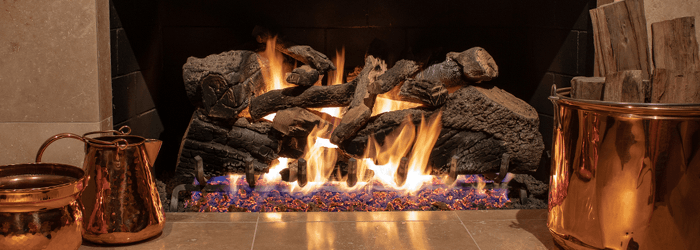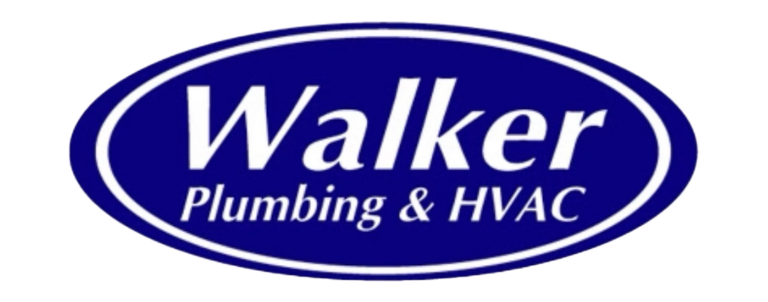As the cooler temperatures take root, it is tempting to fire up the fireplace. However, before striking that first match or turning the gas on, we caution you to practice good fireplace safety.
Wood Burning Fireplace
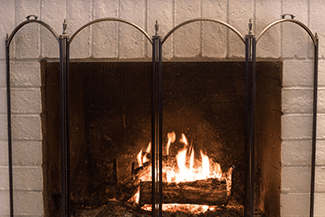 If you used your fireplace last year and have not cleaned it out, you must do that before lighting the first fire of the season. Why? Creosote build-up.
If you used your fireplace last year and have not cleaned it out, you must do that before lighting the first fire of the season. Why? Creosote build-up.
In a wood-burning fireplace, the wood never burns completely. The smoke is a combination of unburned gases and a fog of unburned tar-like liquids. When they come in contact with a cool surface, they condense and form a substance called, Creosote.
Creosote builds up over time, and it’s highly flammable. If it catches on fire, it will get extremely hot very quickly and can burn your house down before help arrives. Creosote can also leave an undesirable odor inside your home.
Cleaning the fireplace and chimney is a messy job. You are better offer hiring a professional chimney sweep. Rebecca Derendal, the owner of Arizona Chimney & Air Ducts, a Rosie on the House Certified Partner, suggests that when hiring a professional, make sure they carry General Liability insurance along with Workers Compensation even if they are self-employed. Take it a step further and find out whether they belong to The National Chimney Sweep Guild and National Fire Protection Association.
Gas Fireplaces
Whenever you use a gas appliance in your home, you run the risk of carbon monoxide poisoning if the gas line is not working properly. Also, an untended gas flame can cause a fire.
Prevent tragedy by taking these precautions.
- Study the manufacturer’s gas fireplace safety instructions.
- Install carbon monoxide detectors on every floor of your house and change the batteries twice a year.
- *Although some tests show that gas fireplaces do not increase carbon monoxide levels in the home, it is still wise to install detectors if you use any gas appliances including a furnace, stove, or fireplace.
- Hire a fireplace professional to inspect and clean the gas log set and glass once a year. Some fireplace dealers offer this service.
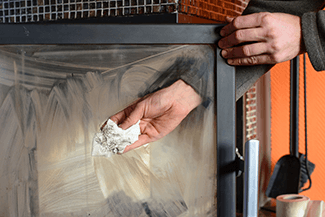 Hire a plumber to inspect and test the gas connections and the fan.
Hire a plumber to inspect and test the gas connections and the fan.- Perform regular maintenance yourself
- Clean and adjust the logs and accessories like the glowing “embers” so they look their best.
- Safety Tip: before cleaning the logs with a damp cloth, wait for the unit to cool completely.
- Clean the fan and air circulation passages.
- Clean the glass after each use.
- Check the batteries in the carbon monoxide detector.
- Make sure vents are unobstructed.
- Clean and adjust the logs and accessories like the glowing “embers” so they look their best.
- Keep children and pets away from the gas fireplace. If your model has glass doors, they will get hot enough to burn little hands and paws that push against it.
- Leave three feet between the fireplace and flammable objects like furniture and curtains.
- Contact your service professional if you smell an unusual odor or if the appearance of the flames change. If you smell gas, leave the house and then call 911.
Converting A Wood-Burning Fireplace to Gas-Burning
If you are converting a wood-burning fireplace to a gas fireplace, keep these things in mind.
Hire a licensed contractor to do the conversion. Working with a gas line or a propane tank is a job for an experienced professional, not a do-it-yourselfer.
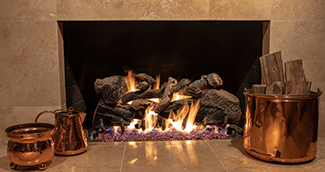
Make sure your contractor installs an oxygen-depletion sensor in your gas fireplace. This device, sometimes called a “safety pilot,” automatically shuts the gas off if the temperature in the fireplace gets too cold or too much carbon monoxide builds up. Insist on having one, even if your gas fireplace is vented.
Check your county and city building codes before installing a gas fireplace to learn about restrictions on where you can place a gas fireplace. Ask your contractor to get a building permit before installing the gas line or propane tank that will fuel your fireplace.
Have the chimney cleaned by a professional chimney sweep before you fire up your gas logs for the first time.
When you convert a wood-burning fireplace to gas, you get to choose the style of your new gas logs and the pattern of the flame. First, decide whether to buy logs that require a vent for the gas byproducts or logs that allow you to burn them without a vent.
For vent-free gas log sets:
Burning gas can deplete the oxygen in your home. If you burn your vent-free logs for more than an hour, crack a window to replace the oxygen. Better still, limit your use of your vent-free gas fireplace to no more than a few hours at a stretch.
For vented gas logs:
Clamp the fireplace damper into the open position so it never closes. The open chimney will allow carbon monoxide to escape. A closed damper will send it into your home, where it can poison your family. The gas is odorless and colorless, and it doesn’t produce smoke as a wood fire does, so you won’t know it’s in the room until developing symptoms, which may be too late.
Holiday Fireplace Tips
Take extra care around the holidays. More highly flammable objects are nearby at this time of year.
DON’T
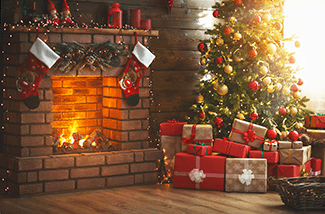 Don’t burn trash. The smoke and ashes can be toxic.
Don’t burn trash. The smoke and ashes can be toxic.- Don’t use a charcoal lighter or kerosene to light the fire. It could flame up.
- Don’t leave small children or pets alone in a room with a fire.
- Don’t leave your home or go to bed while the fire is burning.
DO
- Do use a spark screen while burning and a grate to lay your wood upon.
- Do make sure the damper is open before lighting a fire.
- Do make sure furniture or anything combustible is not too close to the fireplace — that includes Christmas trees.
- Do check the carbon monoxide and smoke alarms annually.
- Do create a fire escape plan and make sure everyone in the household knows what it is and what to do.
Following these tips will ensure that you can safely enjoy the beauty and comfort of a fire in the hearth.
Home Maintenance To-Do | #FireplaceCareUse&Precautions
###
PODCAST
The Weekly To Do on fireplace maintenance. Whether wood or gas, a good cleaning and maintenance check is in order. We explain why we prefer one over the other, how to pronounce some of Arizona’s desert names and cities, and we help homeowners with the right interior door, expansion joint issue.
Podcast Archive With Expanded Content and Resources
PHOTO CREDIT
- Shutterstock

